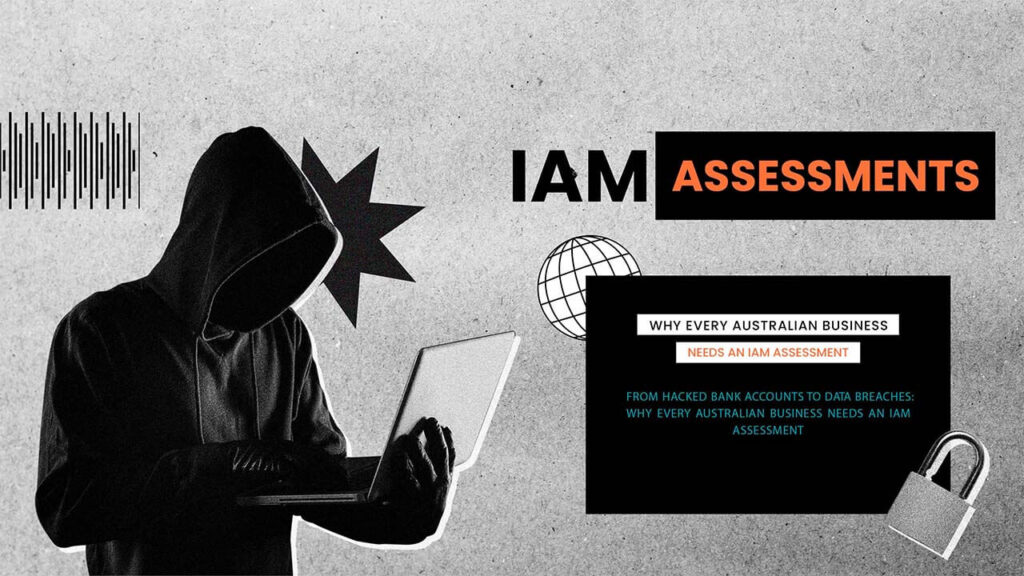
Australian businesses are facing an escalating threat from cybercriminals. Recent high-profile attacks on financial institutions and data breaches serve as stark reminders of the vulnerability of our information systems. From malicious malware to sophisticated phishing scams, businesses of all sizes are potential targets.
In this environment, Identity and Access Management (IAM) emerges as a critical tool for safeguarding sensitive data and systems. IAM helps businesses establish control over who has access to what information, minimising the risk of unauthorised access and data breaches.
This article argues that an IAM assessment is essential for every Australian business, regardless of size or industry. By identifying vulnerabilities and strengthening IAM practices, businesses can proactively mitigate cyber threats and protect their valuable assets.
The Ever-Present Threat Landscape in Australia
Australian businesses operate in a cybersecurity landscape rife with threats, ranging from commonplace scams to advanced exploits. Here are some of the most prevalent attack methods:
- Phishing: Deceptive emails or messages disguised as legitimate sources trick users into revealing sensitive information like login credentials.
- Malware: Malicious software, including viruses, worms, and trojans, can infect systems and steal data, disrupt operations, or render them unusable.
- Ransomware: This form of malware encrypts data, demanding payment for decryption and restoration of access.
- Zero-day attacks: Exploiting previously unknown vulnerabilities in software, these attacks are particularly challenging to defend against due to the lack of existing patches.
The Australian Cyber Security Centre (ACSC) reported a 13% year-on-year increase in cybercrime reports in 2021-2022, with an estimated $33 billion in losses attributed to cybercrime in Australia during the same period.
source: https://www.cyber.gov.au/ .
A recent study by IBM investigates the financial burden of data breaches in 2023: https://www.ibm.com/reports/data-breach
These statistics paint a worrying picture. Beyond the financial losses, cyberattacks can have a devastating impact on businesses, causing:
- Reputational damage: Loss of customer trust and brand loyalty following a data breach or service disruption.
- Operational disruption: System downtime, productivity losses, and hindered ability to deliver services.
- Legal consequences: Potential penalties and fines for non-compliance with data security regulations.
The escalating frequency and severity of cyberattacks make it imperative for Australian businesses to prioritise cybersecurity and take proactive measures to protect their data and systems.
These statistics paint a worrying picture. Beyond the financial losses, cyberattacks can have a devastating impact on businesses, causing:
- Reputational damage: Loss of customer trust and brand loyalty following a data breach or service disruption.
- Operational disruption: System downtime, productivity losses, and hindered ability to deliver services.
- Legal consequences: Potential penalties and fines for non-compliance with data security regulations.
The escalating frequency and severity of cyberattacks make it imperative for Australian businesses to prioritise cybersecurity and take proactive measures to protect their data and systems.
Understanding IAM: A Shield Against Cyberattacks
In the face of a constantly evolving cyber threat landscape, Identity and Access Management (IAM) emerges as a crucial tool for securing sensitive data and systems within organizations.

What is IAM?
IAM offers a holistic solution for securing access to essential assets by managing digital identities effectively. It encompasses three key components:
- Identity Governance: This aspect of IAM deals with establishing clear rules and processes for handling user accounts throughout their lifecycle, from creation to review.
- Access Management: This focuses on defining and enforcing access controls to determine who can access specific data and systems, and to what extent.
- Authentication: This ensures only authorized users gain access to resources through robust verification methods, such as passwords, multi-factor authentication, and biometrics.
How does IAM work?
By implementing these components, IAM establishes a secure framework for controlling user access. It ensures that only the right people have access to the right information at the right time. This significantly reduces the risk of unauthorized access, data breaches, and other cyber threats.
Benefits of Implementing IAM
Businesses that invest in IAM experience a range of benefits, including:
- Improved Compliance: Effective IAM practices help organizations meet regulatory requirements related to data privacy and security, such as the Notifiable Data Breaches (NDB) scheme in Australia.
- Increased Security Posture: IAM strengthens an organization’s overall security posture by minimizing vulnerabilities associated with weak access controls and unauthorized access attempts.
- Enhanced Operational Efficiency: Streamlined IAM processes can improve productivity by automating user provisioning, access requests, and other administrative tasks.
- Reduced Costs: Implementing IAM can reduce the financial impact of cyberattacks by minimizing the chances of data breaches and associated costs of recovery and remediation.
In conclusion, IAM serves as a powerful shield against cyber threats for Australian businesses. By establishing a secure framework for managing user access, organizations can significantly enhance their security posture and protect their valuable assets in the digital age.
Why Every Australian Business Needs an IAM Assessment?
In today’s cyber-threatened environment, conducting an Identity and Access Management (IAM) assessment is critical for Australian businesses of all sizes and across all industries. Regardless of the nature of your business, the sensitive data you handle is a valuable asset vulnerable to cyberattacks.
Why an IAM Assessment is Essential
An IAM assessment offers valuable insights into your organization’s security posture by performing a comprehensive evaluation of your IAM practices. This assessment helps:
- Identify vulnerabilities: It uncovers weaknesses in existing access controls, highlighting potential entry points for unauthorized users and mitigating the risk of data breaches.
- Assess compliance: The assessment ensures your organization adheres to relevant data security regulations, such as the Notifiable Data Breaches (NDB) scheme and the Australian Privacy Principles (APPs).
- Evaluate effectiveness: It assesses the effectiveness of your current IAM practices, pinpointing areas for improvement and suggesting best practices to enhance your overall security posture.
Benefits of an IAM Assessment
Investing in an IAM assessment brings several tangible benefits:
- Early detection: It allows for the early identification of potential security risks before they escalate into costly cyber incidents.
- Improved decision-making: By providing valuable insights into your IAM practices, the assessment empowers businesses to make informed decisions regarding their security strategy and resource allocation.
- Cost savings: By proactively addressing vulnerabilities and preventing cyberattacks, businesses can significantly reduce the financial costs associated with data breaches, including recovery, remediation, and potential fines for non-compliance.
In conclusion, an IAM assessment serves as a proactive measure for Australian businesses to identify and address weaknesses in their security posture. This essential evaluation helps businesses protect their valuable data, ensure compliance, and make informed decisions to secure their future in the ever-evolving digital landscape.
Conducting an IAM Assessment: A Roadmap for Security
An IAM assessment is a multi-stage process that provides a thorough evaluation of your organization’s IAM practices. While the specific steps may vary, generally, it follows this structure:
- Planning: This stage defines the scope and objectives of the assessment, identifies stakeholders, and establishes the assessment team.
- Data Collection: This involves gathering information about your current IAM environment, including user accounts, access controls, and security policies.
- Analysis: The collected data is analyzed to identify vulnerabilities, assess compliance, and evaluate the effectiveness of existing IAM practices.
- Reporting: A comprehensive report is prepared, outlining the findings of the assessment, including identified risks, recommendations for improvement, and potential remediation plans.
- Remediation: Based on the report’s recommendations, concrete steps are taken to address vulnerabilities, strengthen IAM practices, and improve overall security posture.

Seeking Professional Guidance
While organizations can conduct internal assessments, seeking professional guidance from qualified cybersecurity experts is highly recommended. These experts possess extensive knowledge and experience in IAM, allowing them to:
- Design a tailored assessment aligned with your specific needs and industry context.
- Utilize specialized tools and methodologies to ensure a comprehensive and accurate evaluation.
- Provide valuable insights and recommendations based on their expertise and industry best practices.
- Guide you through the remediation process to ensure effective implementation of identified solutions.
By engaging cybersecurity experts, businesses can maximize the effectiveness of their IAM assessment and gain invaluable knowledge to strengthen their security posture in the face of evolving cyber threats.
Building a Secure Future in the Digital Age
This article has highlighted the escalating cyber threat landscape that Australian businesses face and emphasized the crucial role of IAM in safeguarding sensitive data and systems. We have explored the benefits of conducting an IAM assessment, including identifying vulnerabilities, ensuring compliance, and making informed decisions for proactive security measures.
Remember:
- An IAM assessment is an essential step for every Australian business, regardless of size or industry.
- By taking a proactive approach to securing your data and systems, you can significantly reduce the risk of costly cyberattacks and data breaches.
Call to Action:
Don’t wait until it’s too late!
- Contact a qualified cybersecurity expert today to discuss your IAM assessment needs.
- Learn more about IAM and its benefits by visiting the following resources:
- Australian Cyber Security Centre (ACSC): https://www.cyber.gov.au/
- Office of the Australian Information Commissioner (OAIC): https://www.oaic.gov.au/
By taking action now, you can build a more secure future for your business in the ever-evolving digital landscape.
